2014 FORD SUPER DUTY brake fluid
[x] Cancel search: brake fluidPage 12 of 82
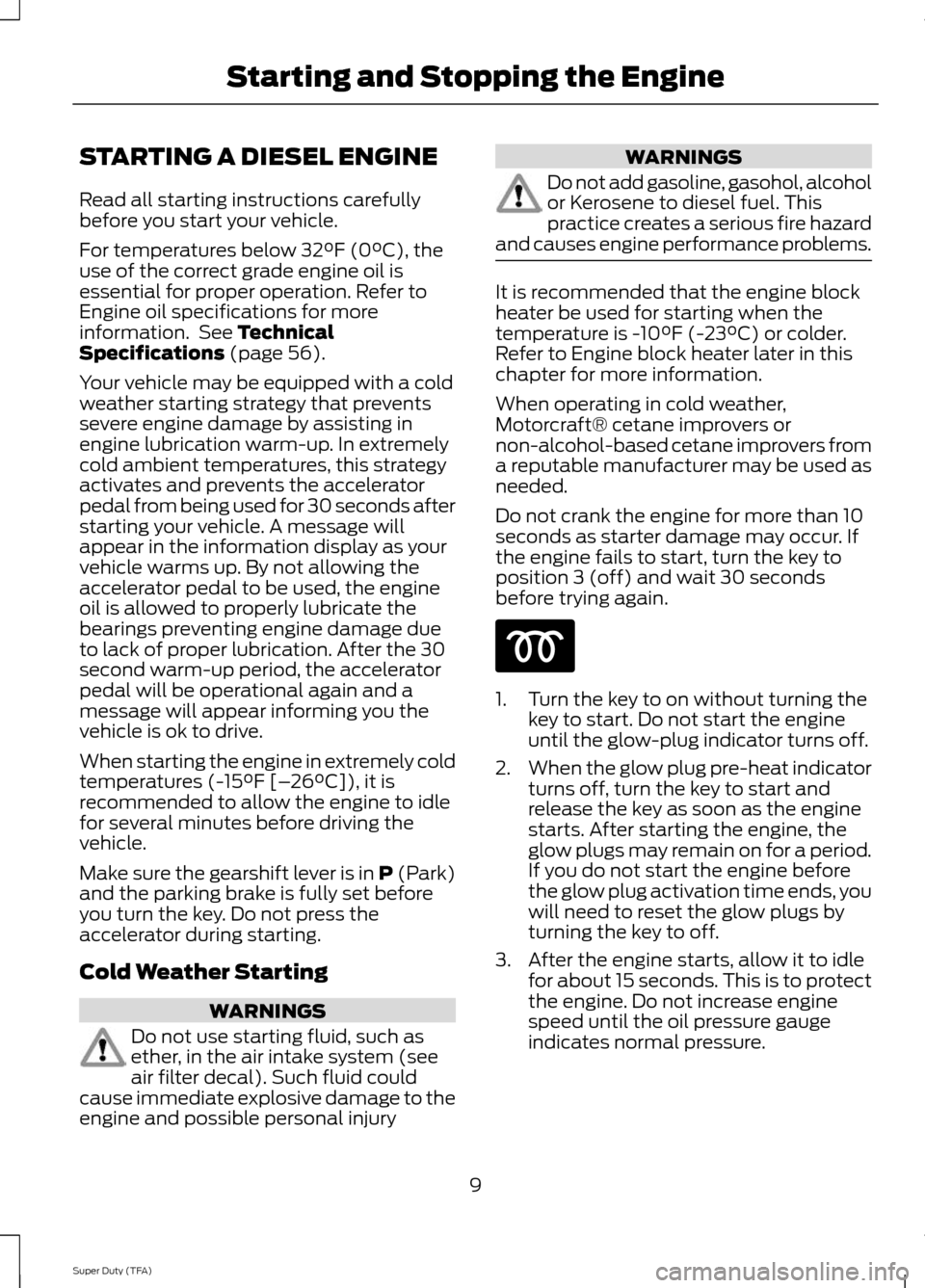
STARTING A DIESEL ENGINE
Read all starting instructions carefully
before you start your vehicle.
For temperatures below 32°F (0°C), the
use of the correct grade engine oil is
essential for proper operation. Refer to
Engine oil specifications for more
information. See Technical
Specifications (page 56).
Your vehicle may be equipped with a cold
weather starting strategy that prevents
severe engine damage by assisting in
engine lubrication warm-up. In extremely
cold ambient temperatures, this strategy
activates and prevents the accelerator
pedal from being used for 30 seconds after
starting your vehicle. A message will
appear in the information display as your
vehicle warms up. By not allowing the
accelerator pedal to be used, the engine
oil is allowed to properly lubricate the
bearings preventing engine damage due
to lack of proper lubrication. After the 30
second warm-up period, the accelerator
pedal will be operational again and a
message will appear informing you the
vehicle is ok to drive.
When starting the engine in extremely cold
temperatures (-15°F [– 26°C]), it is
recommended to allow the engine to idle
for several minutes before driving the
vehicle.
Make sure the gearshift lever is in P (Park)
and the parking brake is fully set before
you turn the key. Do not press the
accelerator during starting.
Cold Weather Starting WARNINGS
Do not use starting fluid, such as
ether, in the air intake system (see
air filter decal). Such fluid could
cause immediate explosive damage to the
engine and possible personal injury WARNINGS
Do not add gasoline, gasohol, alcohol
or Kerosene to diesel fuel. This
practice creates a serious fire hazard
and causes engine performance problems. It is recommended that the engine block
heater be used for starting when the
temperature is -10°F (-23°C) or colder.
Refer to Engine block heater later in this
chapter for more information.
When operating in cold weather,
Motorcraft® cetane improvers or
non-alcohol-based cetane improvers from
a reputable manufacturer may be used as
needed.
Do not crank the engine for more than 10
seconds as starter damage may occur. If
the engine fails to start, turn the key to
position 3 (off) and wait 30 seconds
before trying again.
1. Turn the key to on without turning the
key to start. Do not start the engine
until the glow-plug indicator turns off.
2. When the glow plug pre-heat indicator
turns off, turn the key to start and
release the key as soon as the engine
starts. After starting the engine, the
glow plugs may remain on for a period.
If you do not start the engine before
the glow plug activation time ends, you
will need to reset the glow plugs by
turning the key to off.
3. After the engine starts, allow it to idle for about 15 seconds. This is to protect
the engine. Do not increase engine
speed until the oil pressure gauge
indicates normal pressure.
9
Super Duty (TFA) Starting and Stopping the Engine
Page 25 of 82
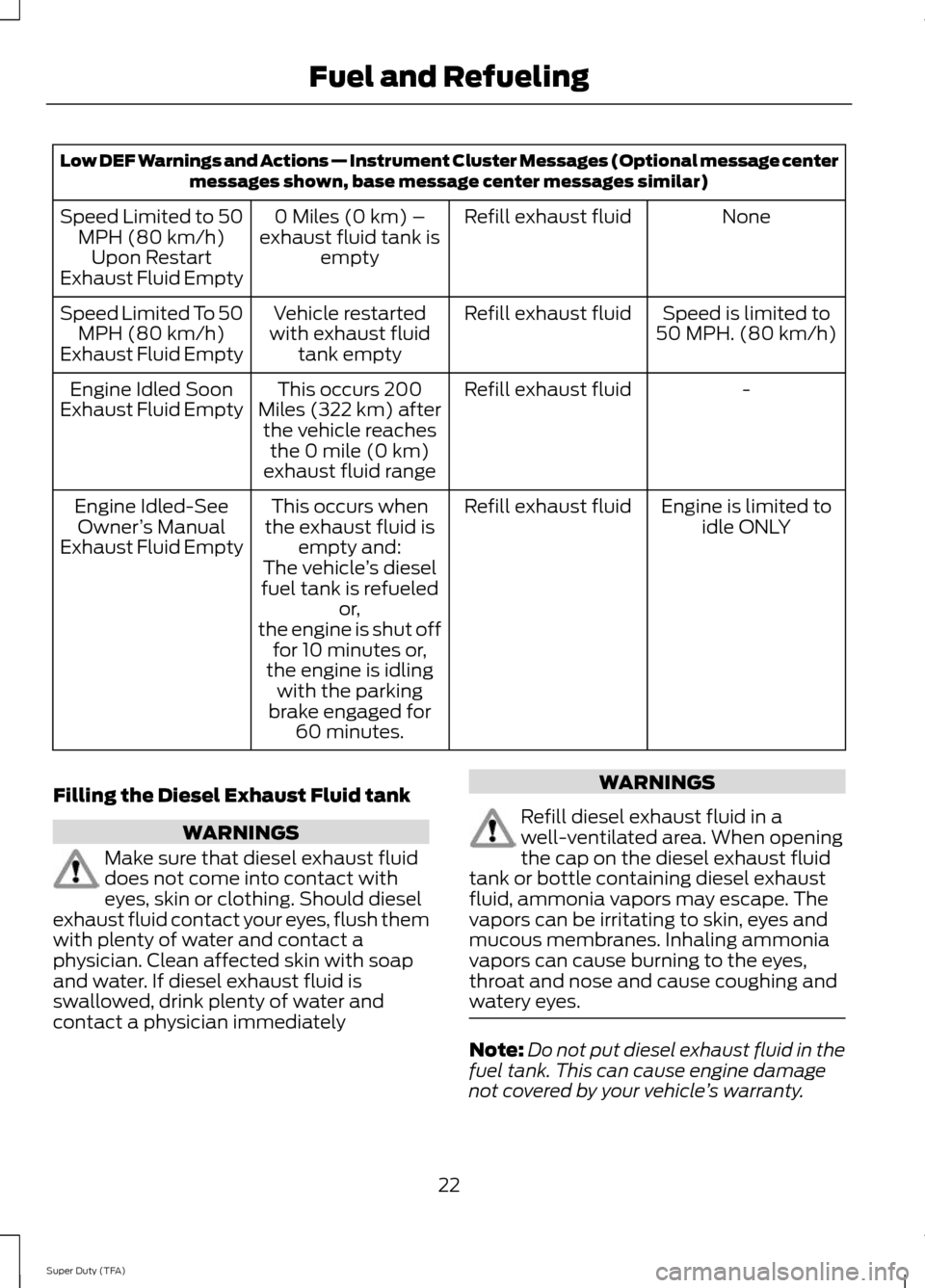
Low DEF Warnings and Actions — Instrument Cluster Messages (Optional message center
messages shown, base message center messages similar)
None
Refill exhaust fluid
0 Miles (0 km) –
exhaust fluid tank is empty
Speed Limited to 50
MPH (80 km/h)Upon Restart
Exhaust Fluid Empty
Speed is limited to
50 MPH. (80 km/h)
Refill exhaust fluid
Vehicle restarted
with exhaust fluid tank empty
Speed Limited To 50
MPH (80 km/h)
Exhaust Fluid Empty
-
Refill exhaust fluid
This occurs 200
Miles (322 km) after the vehicle reaches the 0 mile (0 km)
exhaust fluid range
Engine Idled Soon
Exhaust Fluid Empty
Engine is limited toidle ONLY
Refill exhaust fluid
This occurs when
the exhaust fluid is empty and:
Engine Idled-See
Owner ’s Manual
Exhaust Fluid Empty The vehicle’s diesel
fuel tank is refueled or,
the engine is shut off for 10 minutes or,
the engine is idling with the parking
brake engaged for 60 minutes.
Filling the Diesel Exhaust Fluid tank WARNINGS
Make sure that diesel exhaust fluid
does not come into contact with
eyes, skin or clothing. Should diesel
exhaust fluid contact your eyes, flush them
with plenty of water and contact a
physician. Clean affected skin with soap
and water. If diesel exhaust fluid is
swallowed, drink plenty of water and
contact a physician immediately WARNINGS
Refill diesel exhaust fluid in a
well-ventilated area. When opening
the cap on the diesel exhaust fluid
tank or bottle containing diesel exhaust
fluid, ammonia vapors may escape. The
vapors can be irritating to skin, eyes and
mucous membranes. Inhaling ammonia
vapors can cause burning to the eyes,
throat and nose and cause coughing and
watery eyes. Note:
Do not put diesel exhaust fluid in the
fuel tank. This can cause engine damage
not covered by your vehicle ’s warranty.
22
Super Duty (TFA) Fuel and Refueling
Page 34 of 82
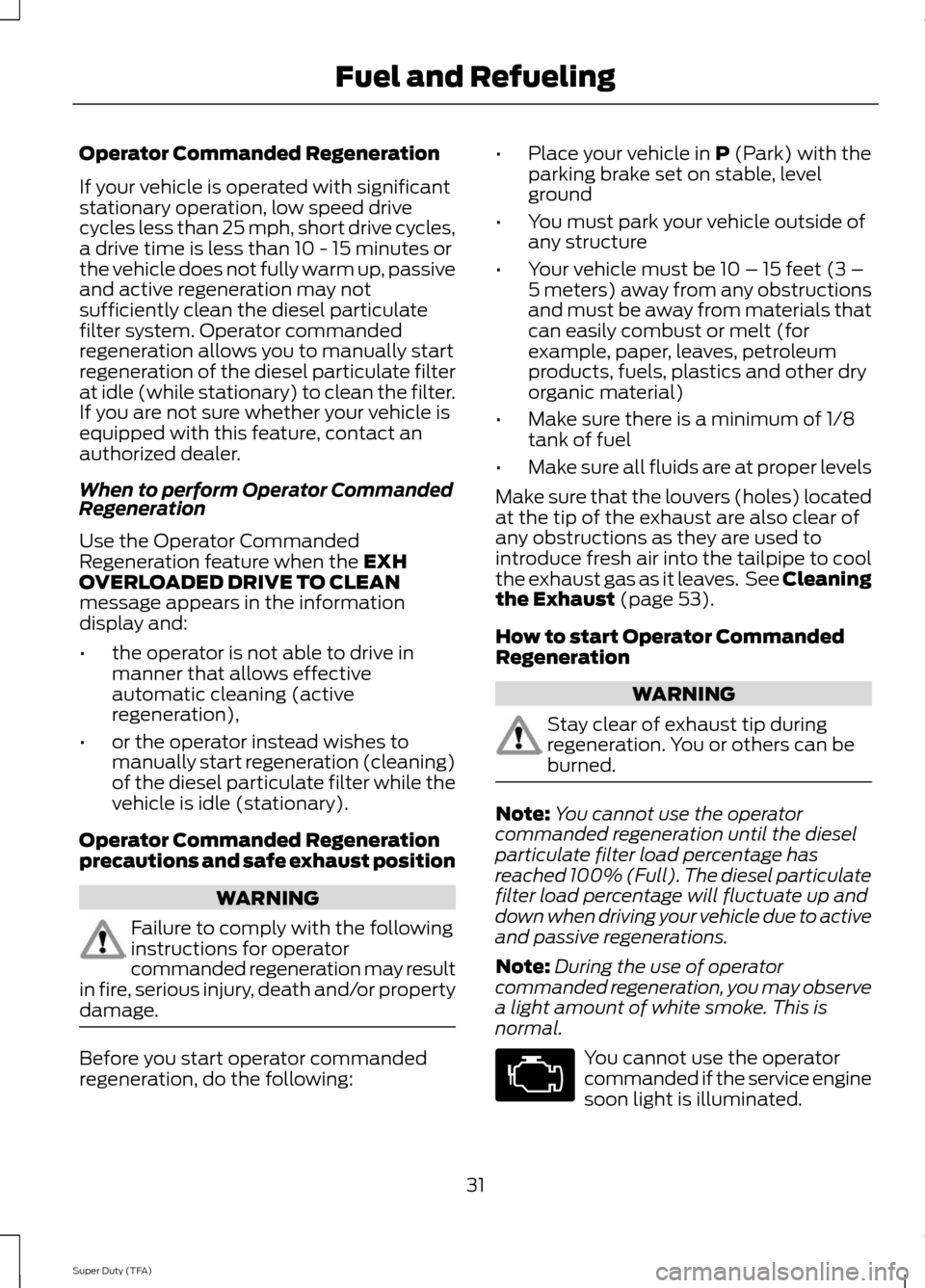
Operator Commanded Regeneration
If your vehicle is operated with significant
stationary operation, low speed drive
cycles less than 25 mph, short drive cycles,
a drive time is less than 10 - 15 minutes or
the vehicle does not fully warm up, passive
and active regeneration may not
sufficiently clean the diesel particulate
filter system. Operator commanded
regeneration allows you to manually start
regeneration of the diesel particulate filter
at idle (while stationary) to clean the filter.
If you are not sure whether your vehicle is
equipped with this feature, contact an
authorized dealer.
When to perform Operator Commanded
Regeneration
Use the Operator Commanded
Regeneration feature when the EXH
OVERLOADED DRIVE TO CLEAN
message appears in the information
display and:
• the operator is not able to drive in
manner that allows effective
automatic cleaning (active
regeneration),
• or the operator instead wishes to
manually start regeneration (cleaning)
of the diesel particulate filter while the
vehicle is idle (stationary).
Operator Commanded Regeneration
precautions and safe exhaust position WARNING
Failure to comply with the following
instructions for operator
commanded regeneration may result
in fire, serious injury, death and/or property
damage. Before you start operator commanded
regeneration, do the following: •
Place your vehicle in
P (Park) with the
parking brake set on stable, level
ground
• You must park your vehicle outside of
any structure
• Your vehicle must be 10 – 15 feet (3 –
5 meters) away from any obstructions
and must be away from materials that
can easily combust or melt (for
example, paper, leaves, petroleum
products, fuels, plastics and other dry
organic material)
• Make sure there is a minimum of 1/8
tank of fuel
• Make sure all fluids are at proper levels
Make sure that the louvers (holes) located
at the tip of the exhaust are also clear of
any obstructions as they are used to
introduce fresh air into the tailpipe to cool
the exhaust gas as it leaves. See Cleaning
the Exhaust
(page 53).
How to start Operator Commanded
Regeneration WARNING
Stay clear of exhaust tip during
regeneration. You or others can be
burned.
Note:
You cannot use the operator
commanded regeneration until the diesel
particulate filter load percentage has
reached 100% (Full). The diesel particulate
filter load percentage will fluctuate up and
down when driving your vehicle due to active
and passive regenerations.
Note: During the use of operator
commanded regeneration, you may observe
a light amount of white smoke. This is
normal. You cannot use the operator
commanded if the service engine
soon light is illuminated.
31
Super Duty (TFA) Fuel and Refueling
Page 44 of 82
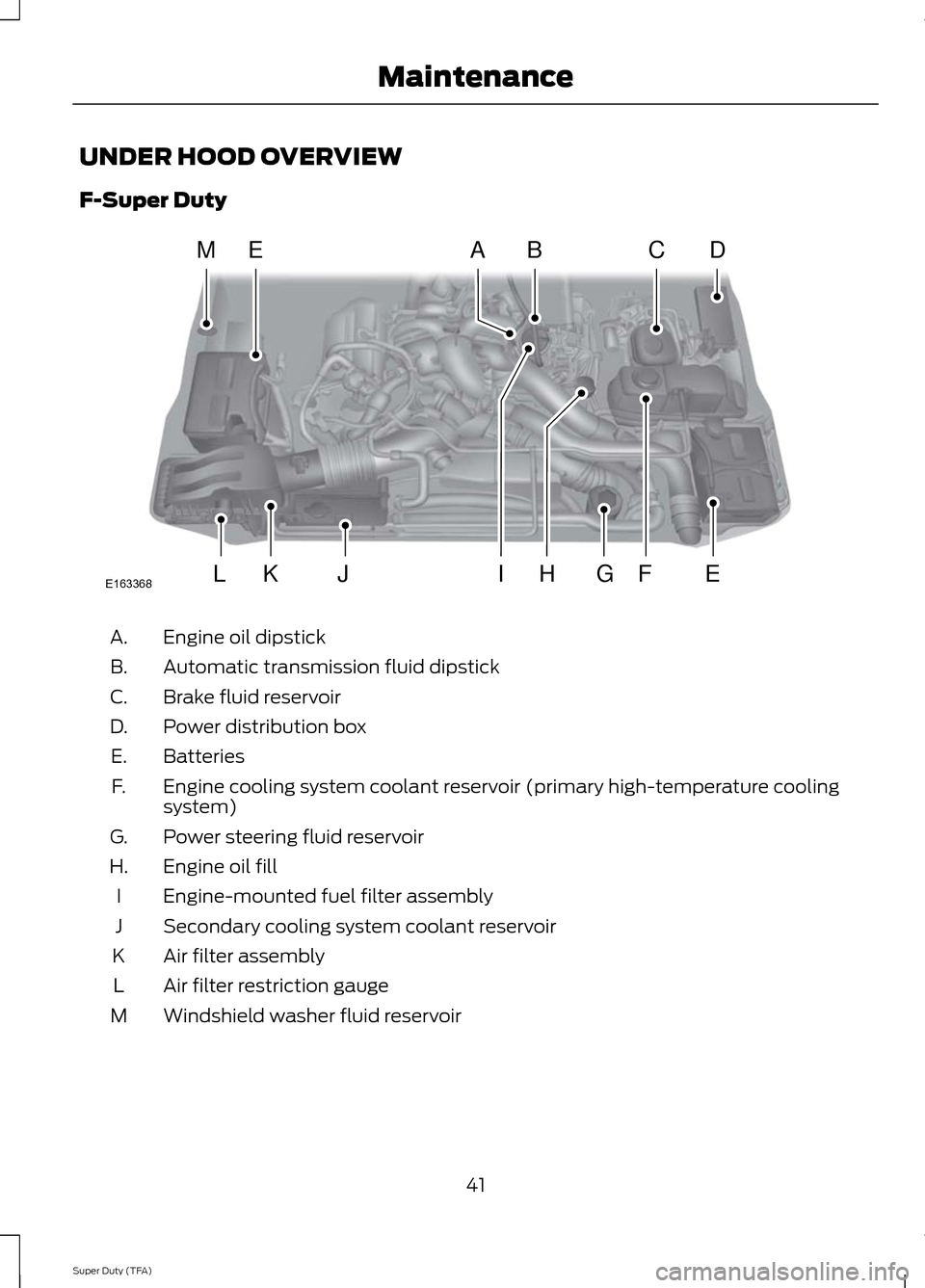
UNDER HOOD OVERVIEW
F-Super Duty
Engine oil dipstick
A.
Automatic transmission fluid dipstick
B.
Brake fluid reservoir
C.
Power distribution box
D.
Batteries
E.
Engine cooling system coolant reservoir (primary high-temperature cooling
system)
F.
Power steering fluid reservoir
G.
Engine oil fill
H.
Engine-mounted fuel filter assembly
I
Secondary cooling system coolant reservoir
J
Air filter assembly
K
Air filter restriction gauge
L
Windshield washer fluid reservoir
M
41
Super Duty (TFA) MaintenanceE163368
MEBC
EGJKLF
DA
HI
Page 63 of 82
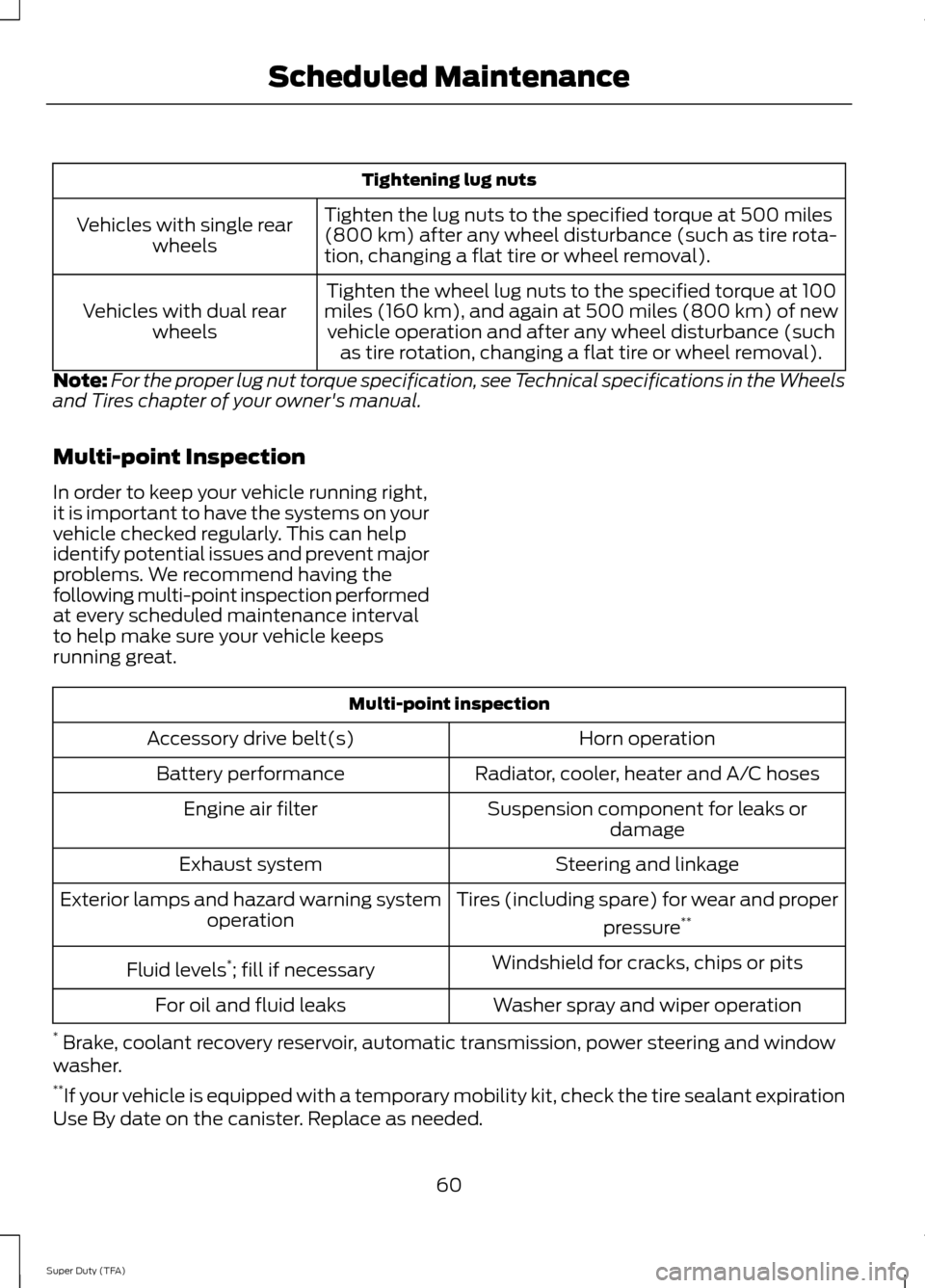
Tightening lug nuts
Tighten the lug nuts to the specified torque at 500 miles
(800 km) after any wheel disturbance (such as tire rota-
tion, changing a flat tire or wheel removal).
Vehicles with single rear
wheels
Tighten the wheel lug nuts to the specified torque at 100
miles (160 km), and again at 500 miles (800 km) of new vehicle operation and after any wheel disturbance (such as tire rotation, changing a flat tire or wheel removal).
Vehicles with dual rear
wheels
Note: For the proper lug nut torque specification, see Technical specifications in the Wheels
and Tires chapter of your owner's manual.
Multi-point Inspection
In order to keep your vehicle running right,
it is important to have the systems on your
vehicle checked regularly. This can help
identify potential issues and prevent major
problems. We recommend having the
following multi-point inspection performed
at every scheduled maintenance interval
to help make sure your vehicle keeps
running great. Multi-point inspection
Horn operation
Accessory drive belt(s)
Radiator, cooler, heater and A/C hoses
Battery performance
Suspension component for leaks ordamage
Engine air filter
Steering and linkage
Exhaust system
Tires (including spare) for wear and properpressure**
Exterior lamps and hazard warning system
operation
Windshield for cracks, chips or pits
Fluid levels *
; fill if necessary
Washer spray and wiper operation
For oil and fluid leaks
* Brake, coolant recovery reservoir, automatic transmission, power steering and window
washer.
** If your vehicle is equipped with a temporary mobility kit, check the tire sealant expiration
Use By date on the canister. Replace as needed.
60
Super Duty (TFA) Scheduled Maintenance
Page 65 of 82
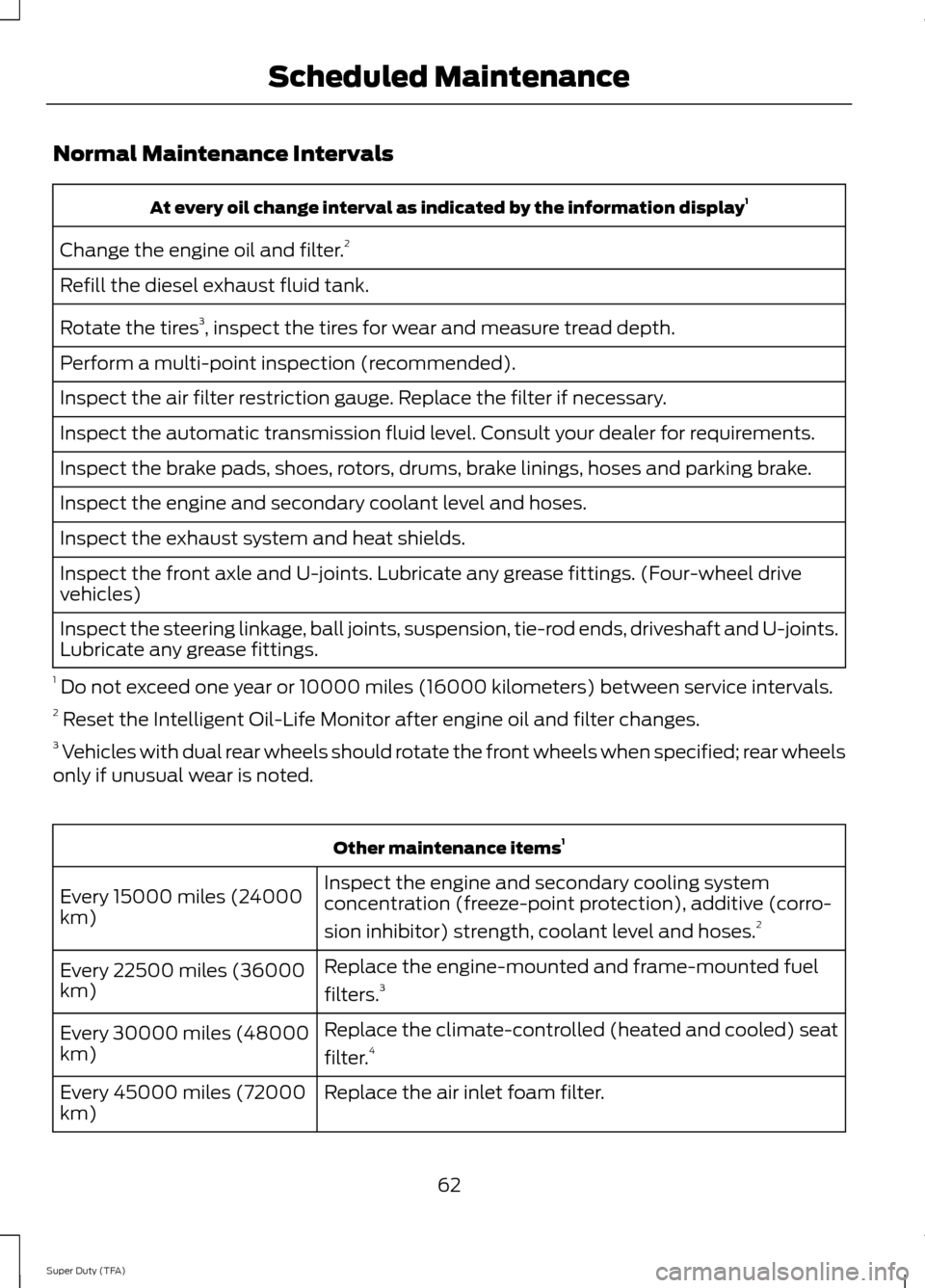
Normal Maintenance Intervals
At every oil change interval as indicated by the information display
1
Change the engine oil and filter. 2
Refill the diesel exhaust fluid tank.
Rotate the tires 3
, inspect the tires for wear and measure tread depth.
Perform a multi-point inspection (recommended).
Inspect the air filter restriction gauge. Replace the filter if necessary.
Inspect the automatic transmission fluid level. Consult your dealer for requirements.
Inspect the brake pads, shoes, rotors, drums, brake linings, hoses and parking brake.
Inspect the engine and secondary coolant level and hoses.
Inspect the exhaust system and heat shields.
Inspect the front axle and U-joints. Lubricate any grease fittings. (Four-wheel drive
vehicles)
Inspect the steering linkage, ball joints, suspension, tie-rod ends, driveshaft and U-joints.
Lubricate any grease fittings.
1 Do not exceed one year or 10000 miles (16000 kilometers) between service intervals.
2 Reset the Intelligent Oil-Life Monitor after engine oil and filter changes.
3 Vehicles with dual rear wheels should rotate the front wheels when specified; rear wheels
only if unusual wear is noted. Other maintenance items
1
Inspect the engine and secondary cooling system
concentration (freeze-point protection), additive (corro-
sion inhibitor) strength, coolant level and hoses. 2
Every 15000 miles (24000
km)
Replace the engine-mounted and frame-mounted fuel
filters.3
Every 22500 miles (36000
km)
Replace the climate-controlled (heated and cooled) seat
filter.4
Every 30000 miles (48000
km)
Replace the air inlet foam filter.
Every 45000 miles (72000
km)
62
Super Duty (TFA) Scheduled Maintenance
Page 70 of 82
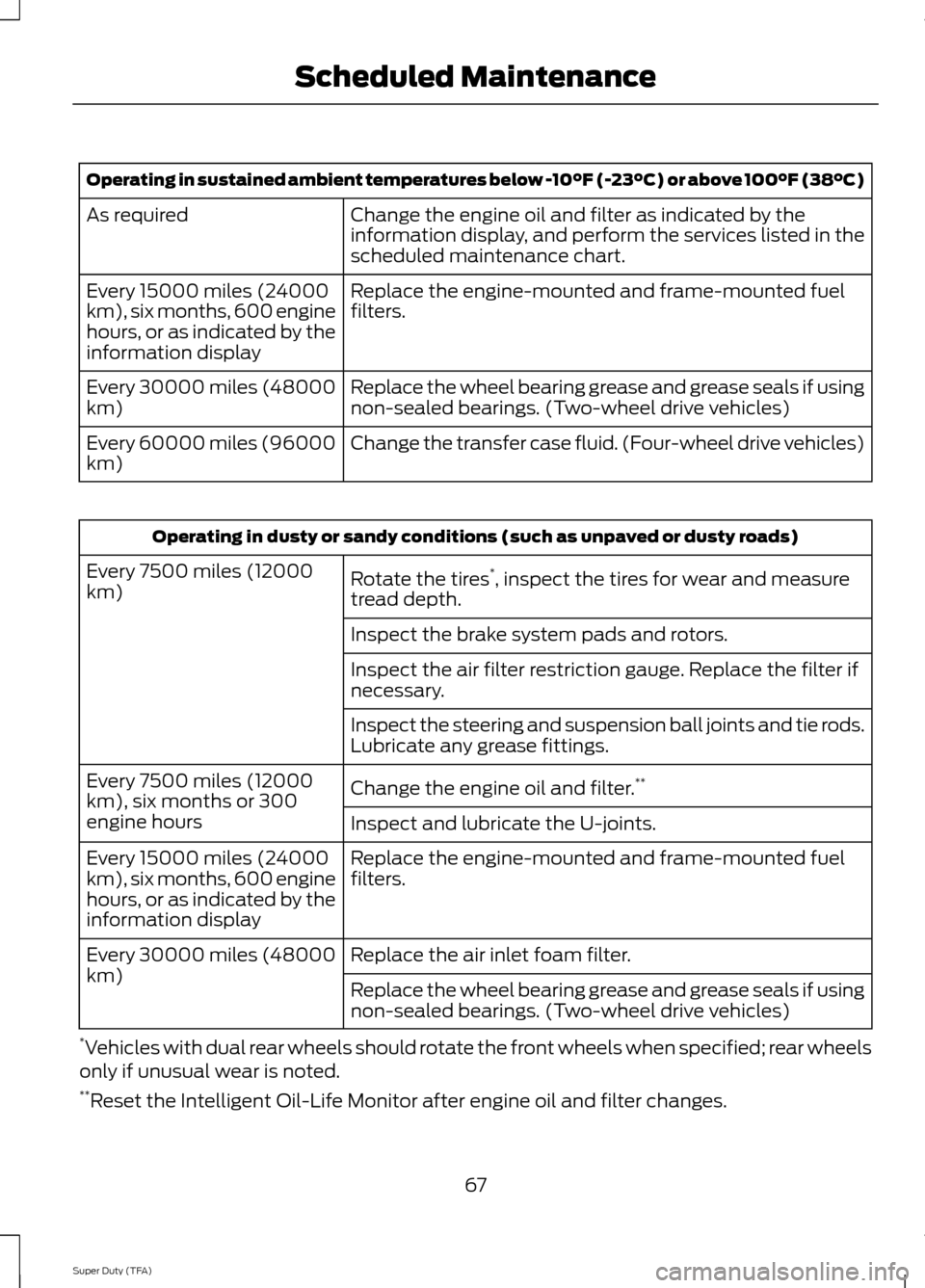
Operating in sustained ambient temperatures below -10°F (-23°C) or above 100°F (38°C)
Change the engine oil and filter as indicated by the
information display, and perform the services listed in the
scheduled maintenance chart.
As required
Replace the engine-mounted and frame-mounted fuel
filters.
Every 15000 miles (24000
km), six months, 600 engine
hours, or as indicated by the
information display
Replace the wheel bearing grease and grease seals if using
non-sealed bearings. (Two-wheel drive vehicles)
Every 30000 miles (48000
km)
Change the transfer case fluid. (Four-wheel drive vehicles)
Every 60000 miles (96000
km) Operating in dusty or sandy conditions (such as unpaved or dusty roads)
Rotate the tires*
, inspect the tires for wear and measure
tread depth.
Every 7500 miles (12000
km)
Inspect the brake system pads and rotors.
Inspect the air filter restriction gauge. Replace the filter if
necessary.
Inspect the steering and suspension ball joints and tie rods.
Lubricate any grease fittings.
Change the engine oil and filter. **
Every 7500 miles (12000
km), six months or 300
engine hours Inspect and lubricate the U-joints.
Replace the engine-mounted and frame-mounted fuel
filters.
Every 15000 miles (24000
km), six months, 600 engine
hours, or as indicated by the
information display
Replace the air inlet foam filter.
Every 30000 miles (48000
km)
Replace the wheel bearing grease and grease seals if using
non-sealed bearings. (Two-wheel drive vehicles)
* Vehicles with dual rear wheels should rotate the front wheels when specified; rear wheels
only if unusual wear is noted.
** Reset the Intelligent Oil-Life Monitor after engine oil and filter changes.
67
Super Duty (TFA) Scheduled Maintenance
Page 71 of 82
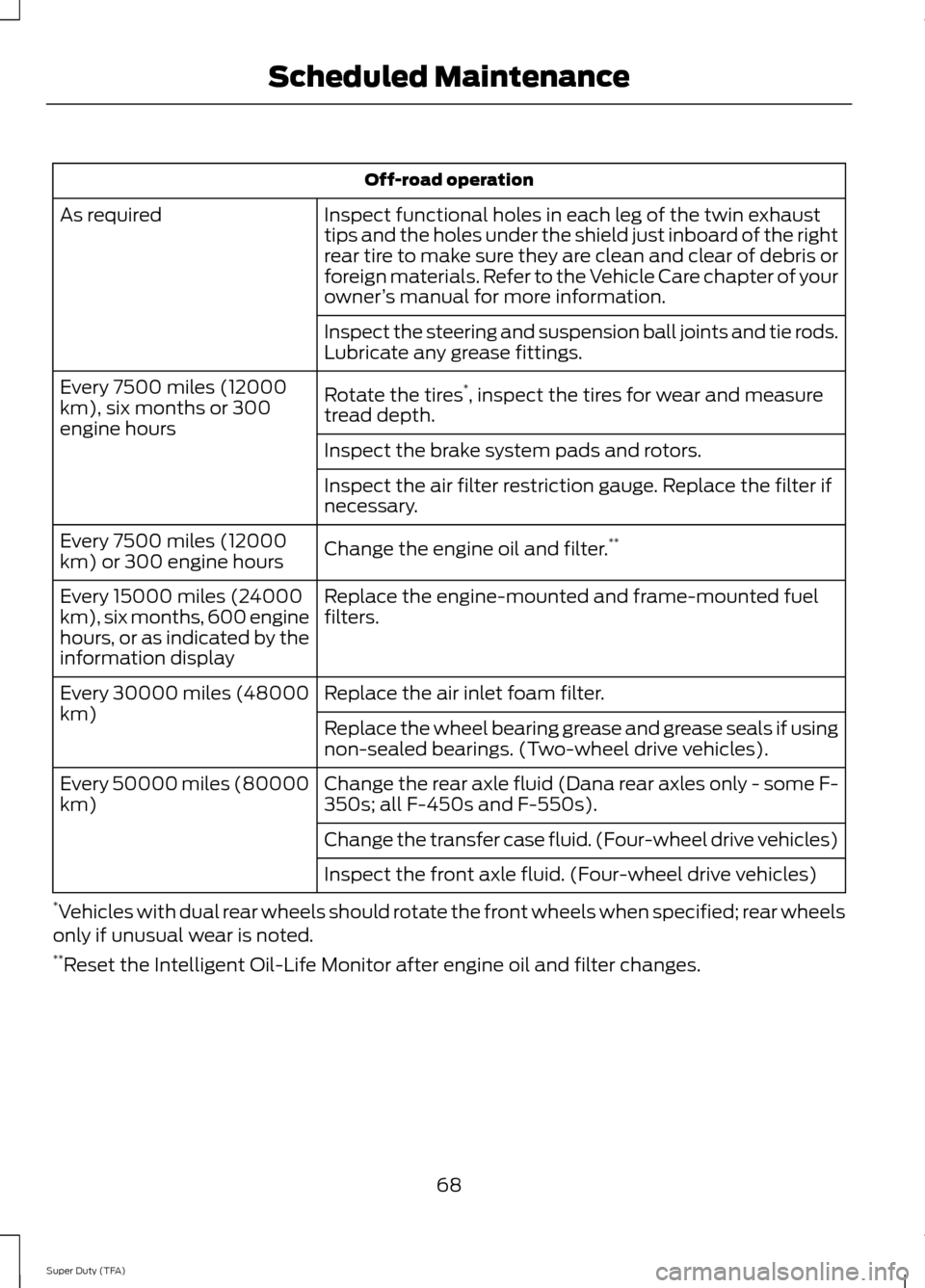
Off-road operation
Inspect functional holes in each leg of the twin exhaust
tips and the holes under the shield just inboard of the right
rear tire to make sure they are clean and clear of debris or
foreign materials. Refer to the Vehicle Care chapter of your
owner ’s manual for more information.
As required
Inspect the steering and suspension ball joints and tie rods.
Lubricate any grease fittings.
Rotate the tires*
, inspect the tires for wear and measure
tread depth.
Every 7500 miles (12000
km), six months or 300
engine hours
Inspect the brake system pads and rotors.
Inspect the air filter restriction gauge. Replace the filter if
necessary.
Change the engine oil and filter. **
Every 7500 miles (12000
km) or 300 engine hours
Replace the engine-mounted and frame-mounted fuel
filters.
Every 15000 miles (24000
km), six months, 600 engine
hours, or as indicated by the
information display
Replace the air inlet foam filter.
Every 30000 miles (48000
km)
Replace the wheel bearing grease and grease seals if using
non-sealed bearings. (Two-wheel drive vehicles).
Change the rear axle fluid (Dana rear axles only - some F-
350s; all F-450s and F-550s).
Every 50000 miles (80000
km)
Change the transfer case fluid. (Four-wheel drive vehicles)
Inspect the front axle fluid. (Four-wheel drive vehicles)
* Vehicles with dual rear wheels should rotate the front wheels when specified; rear wheels
only if unusual wear is noted.
** Reset the Intelligent Oil-Life Monitor after engine oil and filter changes.
68
Super Duty (TFA) Scheduled Maintenance